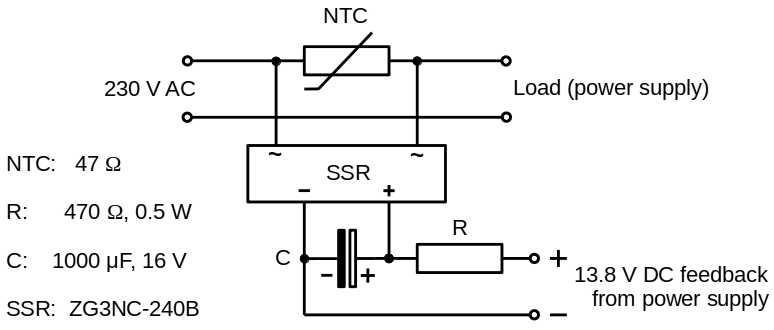

A Soft-Starter Circuit for DC Power Supplies
It is a known fact that rectifiers in DC power supplies are exposed to a strong inrush current each time
the power is turned on. This puts considerable stress on the diodes and may lead to premature failure.
After this happened to my 13.8V/30A power supply, I decided to build a soft-start circuit using parts
from my junk box.
The diagram shows the very simple circuit which consists of only four parts:

|
When the power is turned on, the NTC thermistor is still cold (high resistance) and limits the peak current in
the primary coil of the power transformer to approx. 6 amps. The output voltage of the power supply is fed back
to the input terminals of the solid state relay (ZG3NC-240B, SSR-40 DA, or similar) through a low-pass filter
consisting of R and C (time constant: 0.47 s). As soon as the DC voltage across C exceeds about 3 V, the SSR
becomes conductive and bypasses the thermistor. The voltage drop across the output terminals of the SSR is
negligible. Therefore both SSR and thermistor remain cool during operation. For the same reason, you can switch
the power supply on and off repeatedly without waiting for the thermistor to cool down. However, one should wait
a few seconds until the control LED of the SSR has gone out (SSR non-conductive). It turned out that a heat sink
is not required for the SSR when operating a 100 W transceiver (the SSR used is oversized for this application).
The thermistor should be designed to be used as an inrush current limiter. A disk-shaped type with a diameter
of 2 cm is fine. Theoretically the thermistor could be replaced by a normal 47 Ω wire resistor. The latter,
however, might overheat in case the feedback line gets interrupted during operation. In contrast, the resistance
of NTC thermistors decreases with rising temperature which reduces the voltage drop and limits the power dissipated.
For safety reasons, it might be a good idea to insert a switch and a fuse between power outlet and soft starter.
Only solid-state relays with an integrated opto coupler are suitable for this circuit! SSRs with zero-cross switching
are preferred because they produce less hf noise.
